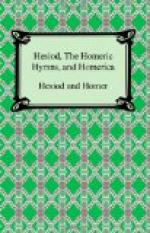were turned into cows).
They were finally healed by
Melampus.
(17) Fl. 56-88 A.D.: he is best known for his work on Vergil.
(18) This and the following fragment segment are meant to be
read together. — DBK.
(19) This fragment as well as fragments #40A, #101, and #102 were
added by Mr. Evelyn-White in an appendix to the second
edition (1919). They are here moved to the “Catalogues”
proper for easier use by the reader. — DBK.
(20) For the restoration of ll. 1-16 see “Ox. Pap.” pt. xi. pp.
46-7: the supplements of ll. 17-31 are by the Translator
(cp. “Class. Quart.” x. (1916), pp. 65-67).
(21) The crocus was to attract Europa, as in the very similar
story of Persephone: cp. “Homeric Hymns” ii. lines 8 ff.
(22) Apollodorus of Athens (fl. 144 B.C.) was a pupil of
Aristarchus. He wrote a Handbook of Mythology, from which
the extant work bearing his name is derived.
(23) Priest at Praeneste. He lived c. 170-230 A.D.
(24) Son of Apollonius Dyscolus, lived in Rome under Marcus
Aurelius. His chief work was on accentuation.
(25) This and the next two fragment segments are meant to be
read together. — DBK.
(26) Sacred to Poseidon. For the custom observed there, cp.
“Homeric Hymns” iii. 231 ff.
(27) The allusion is obscure.
(28) Apollonius `the Crabbed’ was a grammarian of Alexandria
under Hadrian. He wrote largely on Grammar and Syntax.
(29) 275-195 (?) B.C., mathematician, astronomer, scholar, and
head of the Library of Alexandria.
(30) Of Cyme. He wrote a universal history covering the period
between the Dorian Migration and 340 B.C.
(31) i.e. the nomad Scythians, who are described by Herodotus as
feeding on mares’ milk and living in caravans.
(32) The restorations are mainly those adopted or suggested in
“Ox. Pap.” pt. xi. pp. 48 ff.: for those of ll. 8-14 see
“Class. Quart.” x. (1916) pp. 67-69.
(33) i.e. those who seek to outwit the oracle, or to ask of it
more than they ought, will be deceived by it and be led to
ruin: cp. “Hymn to Hermes”, 541 ff.
(34) Zetes and Calais, sons of Boreas, who were amongst the
Argonauts, delivered Phineus from the Harpies. The
Strophades (`Islands of Turning’) are here supposed to have
been so called because the sons of Boreas were there turned
back by Iris from pursuing the Harpies.
(35) An Epicurean philosopher, fl. 50 B.C.
(36) `Charming-with-her-voice’ (or `Charming-the-mind’), `Song’,
and `Lovely-sounding’.
(37) Diodorus Siculus, fl. 8 B.C., author of an universal history
ending with Caesar’s Gallic Wars.
(38) The first epic in the “Trojan Cycle”; like all ancient epics
it was ascribed to Homer, but also, with more probability,
Melampus.
(17) Fl. 56-88 A.D.: he is best known for his work on Vergil.
(18) This and the following fragment segment are meant to be
read together. — DBK.
(19) This fragment as well as fragments #40A, #101, and #102 were
added by Mr. Evelyn-White in an appendix to the second
edition (1919). They are here moved to the “Catalogues”
proper for easier use by the reader. — DBK.
(20) For the restoration of ll. 1-16 see “Ox. Pap.” pt. xi. pp.
46-7: the supplements of ll. 17-31 are by the Translator
(cp. “Class. Quart.” x. (1916), pp. 65-67).
(21) The crocus was to attract Europa, as in the very similar
story of Persephone: cp. “Homeric Hymns” ii. lines 8 ff.
(22) Apollodorus of Athens (fl. 144 B.C.) was a pupil of
Aristarchus. He wrote a Handbook of Mythology, from which
the extant work bearing his name is derived.
(23) Priest at Praeneste. He lived c. 170-230 A.D.
(24) Son of Apollonius Dyscolus, lived in Rome under Marcus
Aurelius. His chief work was on accentuation.
(25) This and the next two fragment segments are meant to be
read together. — DBK.
(26) Sacred to Poseidon. For the custom observed there, cp.
“Homeric Hymns” iii. 231 ff.
(27) The allusion is obscure.
(28) Apollonius `the Crabbed’ was a grammarian of Alexandria
under Hadrian. He wrote largely on Grammar and Syntax.
(29) 275-195 (?) B.C., mathematician, astronomer, scholar, and
head of the Library of Alexandria.
(30) Of Cyme. He wrote a universal history covering the period
between the Dorian Migration and 340 B.C.
(31) i.e. the nomad Scythians, who are described by Herodotus as
feeding on mares’ milk and living in caravans.
(32) The restorations are mainly those adopted or suggested in
“Ox. Pap.” pt. xi. pp. 48 ff.: for those of ll. 8-14 see
“Class. Quart.” x. (1916) pp. 67-69.
(33) i.e. those who seek to outwit the oracle, or to ask of it
more than they ought, will be deceived by it and be led to
ruin: cp. “Hymn to Hermes”, 541 ff.
(34) Zetes and Calais, sons of Boreas, who were amongst the
Argonauts, delivered Phineus from the Harpies. The
Strophades (`Islands of Turning’) are here supposed to have
been so called because the sons of Boreas were there turned
back by Iris from pursuing the Harpies.
(35) An Epicurean philosopher, fl. 50 B.C.
(36) `Charming-with-her-voice’ (or `Charming-the-mind’), `Song’,
and `Lovely-sounding’.
(37) Diodorus Siculus, fl. 8 B.C., author of an universal history
ending with Caesar’s Gallic Wars.
(38) The first epic in the “Trojan Cycle”; like all ancient epics
it was ascribed to Homer, but also, with more probability,




